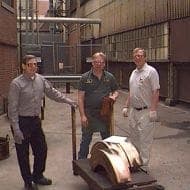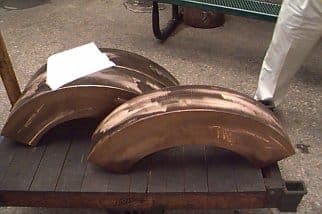
-----
How much CCP will occur in 304 at 1100 °F in 3 hours?
2003
Hello,
I am a sculptor in Cedar Falls, Iowa who makes public art primarily out of stainless steel. Currently, I am using type 304 - 10 gauge sheet. Typically the sculptures are cold fabricated and welded with 304L. By working with a local industry, we are about to color separate sections (2' X 5' X 10') through heating in an industrial furnace that is accurate. These sections are heated to 920 °F and 1100 °F and require 3 hours to pass through the furnace (furnace speed). The temperature was arrived at through testing.
After the forms are colored they will never be heated again and will be bolted and installed outdoors 30 yards from any roadway.
I know that 304 is susceptible to chromium carbide precipitation between ~800-1600 °F.
|
|
|
My questions are:
1. How much CCP is likely to occur in 304 at 920 °F and 1100 & deg. F in 3 hours?
2. Will this CCP cause noticeable corrosion from outdoor exposure with some road salt?
3. Estimate the number of years for the corrosion to become evident and then damaging?
4. Would it help to pull the sections through the furnace faster, i.e. lower the time at temp? [Because of industrial restraints this may be difficult to do - but if it is of great worth it might be tried.]
Any information will be greatly appreciated!
Thank You,
Marc MoultonUniversity of Northern Iowa - Art Department - Cedar Falls, Iowa
Q, A, or Comment on THIS thread -or- Start a NEW Thread

